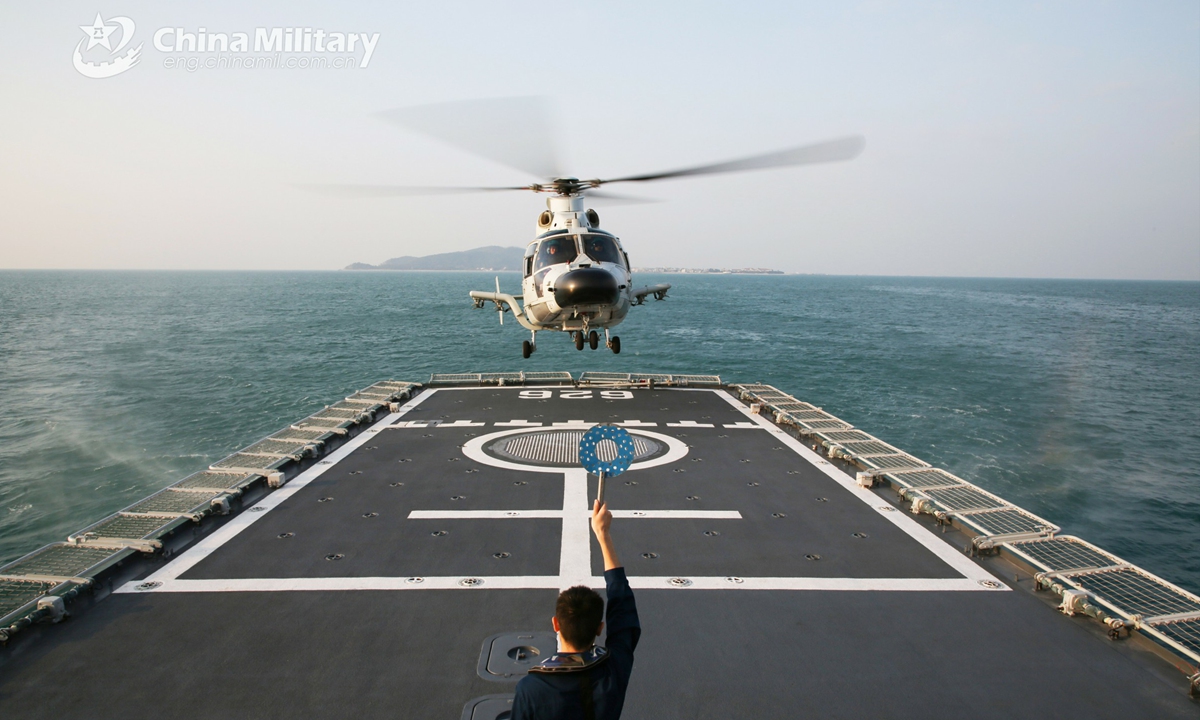
A ship-borne helicopter attached to a frigate flotilla with the navy under the PLA Southern Theater Command lands on the flight deck of the guided-missile frigate Wuzhou (Hull 626) under the guidance of a sailor during a maritime fire-fighting training operation in early December, 2021.Photo:China Military
The US held more than 100 large-scale military exercises near China last year, practicing and validating several new war concepts targeting the country, a Beijing-based think tank revealed on Sunday, shortly before the US and the Philippines are reportedly about to launch the "largest-ever" joint drills on Monday.
A major reason behind the extensive drills with new tactics is that the US is aiming to contain China but is faced with the rapid development of the Chinese People's Liberation Army (PLA), and the US military is worried that its traditional instruments of war are becoming obsolete facing the PLA, analysts said.
Based on publicly available information, the US military conducted 95 exercises in and near the South China Sea in 2021, with the actual number exceeding 100, the South China Sea Strategic Situation Probing Initiative (SCSPI) said in a report released on Sunday.
Among the 95 drills, 14 consisted solely of arms of the US military, including the Navy, Air Force, Marine Corps, Army and Coast Guard. They featured training courses including anti-ship, anti-submarine, anti-sea mine, amphibious, cyberspace and maritime situational awareness missions.
The other 81 were joint exercises with other countries including those along the coastlines of the South China Sea as well as those from outside the region including Japan, the UK, Australia, India, France and Canada, the SCSPI report said, noting that both the frequency and scale of the drills reached new highs.
In 2021, the US military successively sent strategic platforms including four carrier strike groups, two amphibious ready groups, 11 nuclear-powered attack submarines and carried out 22 bombers sorties. This was in addition to conducting at least 1,200 aerial close-in reconnaissance sorties with large spy aircraft and 419 ship days of maritime survey and surveillance with spy ships to the South China Sea, with an obvious intent to deter China, the SCSPI said.
The US also tried to validate some of its new war concepts like multi-domain operations, expeditionary advanced base operations, distributed maritime operations and littoral operations in a contested environment, as the US now acknowledges that China has the edge in the air and sea within the first island chain, the SCSPI said, citing US documents on the Indo-Pacific Strategy.
The reason why the US military is developing new war concepts is that it knows all established US military bases, including those in Japan and South Korea as well as aircraft carriers, are no longer secure, so it needs more bases and it also needs to make them more mobile in a more distributed manner, Song Zhongping, a Chinese military expert and TV commentator, told the Global Times on Sunday.
The US military is worried and panicked to see the growing combat capabilities of the PLA as the gap between them narrows quickly, so the US is looking not only at developing a new generation of weapons and equipment, but also creating new tactics and ways to engage in combat, Song said.
New technologies, including standoff hypersonic weapons, antiballistic missile technologies, precision strike and missile defense systems, new maritime combat systems, directed energy weapons, next-generation nuclear-powered attack submarines and destroyers are all under development by the US, the SCSPI said.
While the US is attempting to deter its imagined possibility of a "China expansion" by a frontier military presence, excessive deterrence would only result in more resolute countermeasures from China, and that will be the opposite of what the US wants, the SCSPI said.
Deterrence and countermeasures as well as provocation and counter-provocation will be major strategic and tactical questions China and the US will have to deal with in the future, the report said.
The report was released only one day before the annual US-Philippines Balikatan Exercise was scheduled to kick off. Media report said this year's Balikatan Exercise would be the "largest-ever," with about 5,100 US military personnel and 3,800 personnel from the Philippines participating from Monday to April 8 across Luzon.

In 2021, the US military strategy and operation on the South China Sea is featured by deterrence----strengthening forward military presence and targeted activities, to deter the imaginary "China might overreach".





